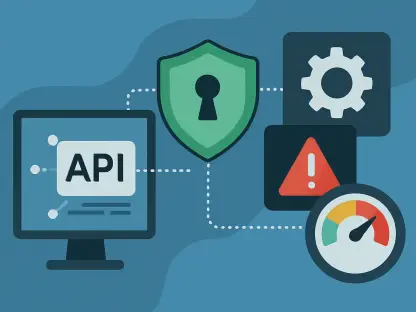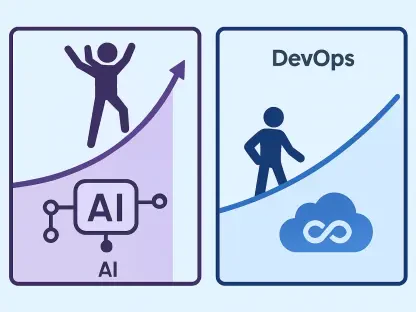In today’s digital landscape, where every millisecond of website load time can impact user satisfaction and business outcomes, the challenge of monitoring and optimizing web performance has never been more critical, especially given the complexity of Internet performance across multiple layers. These layers span from a user’s device and browser to DNS lookups, network routes, edge configurations, and origin server locations, introducing variables like last-mile bandwidth limitations, third-party script delays, or constrained CPU resources, often hidden without robust observability tools. Performance engineers frequently struggle to correlate disparate metrics like front-end events, network processing times, and server-side logs to identify the root causes of latency. Addressing this intricate puzzle requires innovative solutions that provide comprehensive insights while maintaining user trust. A groundbreaking upgrade in performance analytics is on the horizon, promising to revolutionize how developers debug and optimize applications by tracing issues end-to-end across the Internet. This development aims to deliver clarity and actionable data, ensuring that performance bottlenecks are not just identified but resolved efficiently.
1. The Critical Role of Detailed Performance Insights
Understanding the intricacies of web performance demands tools that offer granular visibility into every layer of the Internet stack. Current monitoring solutions often fall short, providing fragmented data that leaves developers guessing about the true source of delays. The importance of detailed insights cannot be overstated, as they empower teams to pinpoint issues with precision, whether they stem from client-side rendering or server-side processing. Equally vital is the trust users place in platforms to safeguard their privacy while performance data is collected. A balance must be struck between deep analytics and ethical data handling, ensuring that monitoring tools reveal critical performance metrics without compromising personal information. This dual focus on visibility and privacy sets the stage for transformative advancements in how performance is measured and improved.
Moreover, the integration of real user metrics with network-level data offers a holistic view that was previously unattainable. Developers can now dissect performance issues across various dimensions, identifying whether a slowdown originates from a user’s browser, a network hiccup, or an origin server bottleneck. This comprehensive approach not only highlights where problems occur but also provides clues on why they happen, enabling targeted optimizations. By prioritizing privacy alongside such detailed analytics, emerging tools ensure that user data remains protected through methods like aggregation and anonymization. This commitment to ethical practices builds confidence among users and developers alike, fostering an environment where performance monitoring can evolve without overstepping personal boundaries.
2. Addressing the Gaps in Traditional Monitoring Tools
Many existing performance monitoring solutions offer only a narrow perspective, focusing either on client-side experiences or origin server metrics while glossing over the intermediary steps as a vague “processing time.” This lack of clarity hinders teams from fully understanding the performance landscape, especially as web applications grow increasingly complex and user expectations for speed continue to rise. Knowing that a delay occurred is merely the starting point; modern teams need deeper insights into why bottlenecks happen, whether due to network conditions, recent code updates, or the impact of external scripts. Without this level of detail, optimizing load times becomes a guessing game, leaving developers unable to implement effective solutions that address the root causes of performance degradation.
To illustrate these challenges, consider the case of an e-commerce site owner based in Detroit, managing a global business selling niche products. Despite consistent efforts to monitor site performance locally, complaints about slow load times from customers in distant regions like Germany persist. Off-the-shelf tools identify “server processing time” as the culprit, yet fail to clarify whether the issue lies with the server itself, the transit connections of international users, or another factor entirely. This ambiguity leaves the business owner grappling with unanswered questions about whether to invest in additional servers, tweak CDN settings, or explore other fixes. Such scenarios highlight the pressing need for monitoring solutions that break down vague metrics into actionable insights, offering clear guidance on where and how to improve performance for a global audience.
3. Unveiling the Power of Web Analytics
A significant leap forward in performance monitoring comes with the introduction of Web Analytics, a tool designed to uncover performance bottlenecks through real user data. Set to be enabled by default for free domains starting October 15, this solution involves embedding a lightweight JavaScript snippet on websites to capture critical metrics directly from visitors’ browsers. Accessible via the Analytics & Logs section of a comprehensive dashboard, it provides aggregated data on browser rendering performance, including metrics like Largest Contentful Paint (LCP), Interaction to Next Paint (INP), and Cumulative Layout Shift (CLS), alongside server processing times and visitor counts. This direct measurement from real users offers a more accurate reflection of performance compared to synthetic tests, equipping developers with the data needed to enhance user experiences systematically.
The architecture behind this tool is both efficient and user-focused, starting with a small JavaScript beacon that loads asynchronously to avoid interfering with page rendering. This snippet taps into modern browser APIs to gather detailed performance data, such as resource load times and TLS handshake durations. Data is then transmitted to the nearest data center for preprocessing, where personal information is stripped out to protect privacy, and storage needs are minimized before being sent to a core facility for user queries. Setup is straightforward, with automatic activation for free domains and options for manual snippet placement for other account types. Additionally, resource attribution tables in the dashboard highlight slow-loading assets, enabling developers to prioritize optimizations that directly impact user-perceived performance, thus transforming raw data into practical improvements.
4. Commitment to a Privacy-First Framework
At the core of modern Web Analytics lies a steadfast dedication to privacy, ensuring that performance insights are gained without infringing on user data. Unlike some tools that rely on invasive tracking methods, this approach avoids storing personal identifiers such as IP addresses, User Agents, or employing fingerprinting techniques. No client-side state, like cookies or localStorage, is used for analytics purposes, preserving user anonymity while still delivering valuable performance metrics. Furthermore, options are available to exclude data collection from specific regions like the EU and UK, with default settings ensuring that such traffic is not monitored unless explicitly adjusted in the dashboard, aligning with global privacy expectations.
This privacy-first model extends beyond client-side data to encompass network and origin metrics, maintaining a consistent ethical stance across all layers of performance analysis. Instead of tracking individual users, the system counts page views based on distinct referral or navigation events, a method that sidesteps the storage of potentially personal information. This concept of a “visit” as the unit of measurement ensures that developers receive the insights needed to address performance issues without accumulating unnecessary data about site visitors. By embedding such principles into the foundation of Web Analytics, the platform not only meets regulatory and ethical standards but also fosters trust among users, proving that powerful monitoring tools can coexist with stringent privacy safeguards.
5. Options for Opting Out of Web Analytics
While Web Analytics offers substantial benefits for performance monitoring, provisions are in place for those who prefer not to participate. For free domains wishing to opt out before the automatic activation on October 15, a clear process via the dashboard is available. Begin by navigating to the specific zone within the dashboard, then locate Web Analytics in the left-side menu. From there, select activation settings such as Enable Globally or Exclude EU to initiate the feature. Subsequently, access Manage RUM Settings in the Web Analytics section, and choose Disable to deactivate it for the zone, or use Advanced Options to delete configurations entirely. Once disabled, the feature will not be re-enabled automatically, though manual reactivation remains an option at any time.
For those preferring a programmatic approach, opting out via API provides an alternative method. Start by creating a configuration with an API call, setting auto_install to false to prevent data collection. Collect the site_tag and zone_tag from the response to proceed with further actions. Then, either disable the configuration by making another API call with enabled set to false, or delete it entirely using a DELETE request. These steps ensure that zones are not inadvertently enrolled in data collection, offering flexibility for developers and site owners to align monitoring practices with their specific policies or preferences. This dual approach through dashboard and API underscores the commitment to user control over performance analytics participation.
6. Looking Ahead to Enhanced Performance Capabilities
The current iteration of Web Analytics already provides valuable insights into browser-based user experiences, but upcoming enhancements promise to broaden this perspective significantly. Future updates will encompass the entire request journey, tracing performance from a user’s initial click through global networks to origin servers and back. This expanded visibility will enable developers to dissect every stage of a request, identifying delays whether they occur in client interactions, network transit, or server responses. Such comprehensive coverage aims to eliminate blind spots in performance monitoring, ensuring that no aspect of the user experience is left unexamined or unoptimized.
Key features on the horizon include correlating data across layers by matching real user metrics with network timing, edge processing, and origin latency to pinpoint specific causes of delays like slow scripts or cache misses. Configurable alerts will notify teams of performance regressions in particular regions or spikes in origin latency, while detailed breakdowns of “processing time” will reveal specific steps such as proxy routing or security checks. All these insights will be integrated into a unified dashboard alongside analytics, logs, and configurations, facilitating a seamless workflow for identifying cause and effect. These advancements are poised to redefine performance monitoring by offering not just data, but actionable strategies to enhance speed and reliability across diverse digital environments.
7. Building a Future of Collaborative Innovation
Reflecting on the strides made in performance analytics, it’s evident that a transformative shift occurred with the integration of privacy-focused tools into everyday monitoring practices. Developers gained unprecedented access to detailed insights that illuminated every facet of the request journey, from browser to origin, enabling precise optimizations that enhanced user experiences worldwide. This journey, chronicled through ongoing updates, showcased a commitment to evolving solutions in full view of the community, ensuring that each advancement was shaped by real-world needs and feedback. The past efforts laid a robust foundation for tackling performance challenges with clarity and confidence.
Looking forward, the next steps involve deepening this collaborative spirit by rolling out features like proactive alerts and cross-layer correlations that promise unique, actionable recommendations. These developments aim to empower teams to not only react to performance issues but anticipate them, fostering a proactive approach to digital optimization. For those eager to stay informed, following along with detailed chronicles of this journey offers a front-row seat to innovation in action. Additionally, exploring broader resources for faster, safer Internet experiences or delving into the mission behind building a better digital landscape provides further avenues for engagement. This path forward ensures that performance monitoring continues to evolve, delivering tools and insights that keep pace with the ever-changing demands of the online world.









